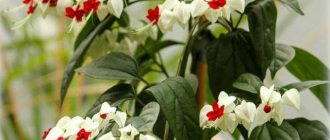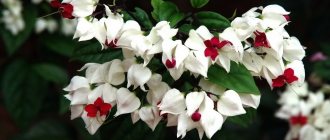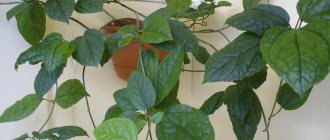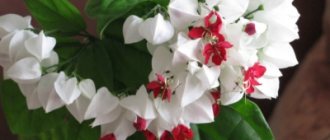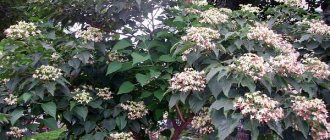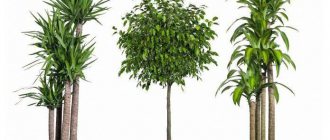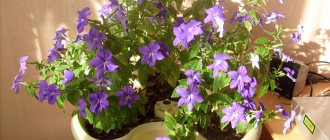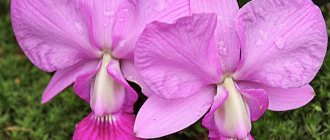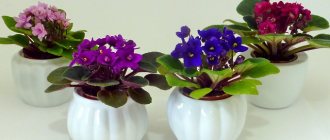Clerodendrum Ugandan - an indoor vine with lush foliage and fancy bright flowers, is a real decoration for the windowsill. There is a belief that this tropical flower, which came from East Africa, brings happiness and good luck to the home. However, in order for the vine to please the eye with lush flowering, it is important to know how to care for it at home and protect it from possible pests and diseases.
The plant is ideal for vertical gardening of a loggia
Description
is popularly called “blue butterflies” due to the butterfly-shaped flowers The length of the leaves can reach 10 cm, the color of the leaves is dark green, thin woody shoots can reach a length of 2.5 m. The flowering period lasts from spring to autumn, the leaves have a bluish tint.
You can also find other types of Clerodendrum on our website: Clerodendrum Wallich, Clerodendrum Thompson, Clerodendrum Philippine.
Common problems when growing
Rare watering and dry air provoke falling and yellowing of leaves and buds. Cold drafts cause the leaves to darken. Clerodendrum is very sensitive to its environment. Temperature, mode and air humidity play a key role for it. It is necessary to carefully monitor the exotic representative. The better you take care of it, the more beautiful it will become.
Clerodendrum from Uganda can be grown at home, although you will have to tinker. The main thing is careful attention and regular checks for diseases or complications. In order for a representative of the flora to always be beautiful, you need to carry out a number of procedures, which are outlined in the material above.
Photo
You can clearly see the Clerodendrum Ugandan in the photo:
Types and varieties of clerodendrum
Wallich's Clerodendrum or Prospero (Clerodendrum Prospero), which is also called “Cleopatra's tears”. The most capricious species to grow comes from Bangladesh, India and southern China.
It received its name in honor of the Danish botanist and explorer Wallich Nathaniel, who discovered this species while participating in scientific expeditions to India.
The height of the plant is about half a meter. Its characteristic feature is large shiny dark green, leathery leaves with wavy edges about 15 cm in length. Numerous snow-white flowers are collected in drooping clusters. Wallich Nathaniel was delighted by the exotic beauty of Clerodendrum Prospero.
Thompson's clerodendrum (Clerodendrum thomsoniae). The most common species in indoor culture comes from West Africa. It got its name in honor of the missionary priest and doctor William Cooper Thomson, who spent a lot of time in Nigeria. The elastic shoots of the evergreen vine are covered with large leaves with visible veins.
The flowers are bright red tubular, surrounded by snow-white, pink or pale purple or red bell-shaped petal bracts, collected in racemes of loose inflorescences.
In addition to the magnificent flowering of this species, there are decorative deciduous hybrids of the "Variegatum" group with marble-green foliage that complements the beauty of the flowers.
Clerodendrum variegata
Popular and showy variety 'Delectum' with pink-purple flowers in very large inflorescences, 'Bleeding Heart Vine' with bright red blooms.
Ugandan Clerodendrum is native to the mountainous regions of East Africa. One of the most famous species, often called the “Blue Butterfly” due to the special shape of the flowers.
The plant is a fast-growing vine about 2 m long. The inflorescence consists of 5 flowers of a pale blue or purple hue. The pruning procedure allows you to form a bush shape.
Clerodendrum speciosum is another member of the genus, native to Polynesia and New Guinea.
It is a bush with scarlet flowers and pink bracts, blooming profusely throughout the summer.
Philippine clerodendrum (C. philippinum). A fast-growing shrub species that is easy to care for and blooms already in the 2nd year of life.
Characterized by beautiful large double flowers with a strong jasmine aroma with hints of vanilla.
Clerodendrum Schmidtii (C. schmidtii) is a shrub or small tree with several stems and drooping shoots.
White fragrant flowers cascading in loose long inflorescences. Fully open, the flowers resemble white butterflies.
Flower stems are dark red.
Flowering occurs mainly in winter.
Can be grown both on a trunk and in hanging pots.
Clerodendrum inerme. A hardy, branching shrub with long flexible shoots, reaches a height of 3 meters in its natural habitat, but at home the height is controlled by pruning. Well suited for growing bonsai.
The leaves are almost round and shiny. The plant blooms almost all the time. The flowers are white and very fragrant, with long purple stamens. There is also a variegated form of the plant with golden-green leaves.
Clerodendrum splendens is an evergreen woody vine growing up to 3 - 4 m in length.
The leaves are large, ovate, shiny, panicle inflorescences are 12-15 cm in diameter, and consist of bright scarlet flowers. Blooms almost all year round.
Clerodendrum Bunge (C. Bungei). A low bush with large, unpleasantly smelling, ovoid leaves.
Young leaves often have a purple tint.
"Pink Diamond"
Fragrant pink flowers are collected in a round inflorescence. Popular variety with variegated foliage: 'Pink Diamond'. Blooms from late summer and throughout autumn.
Home care
If you decide to get a Ugandan clerodendrum, caring for it at home will not be difficult. It is best to place the flower in southern directions; in spring and summer it is recommended to place the plant on the loggia, during this period the most favorable conditions are created for it.
The northern direction is considered the worst for clerodendrum; there may be problems with the appearance of flowers; to improve conditions, it is necessary to use additional lighting with phytolamps.
Read more about caring for Clerodendrum here.
Trimming
Pruning is considered a necessary procedure; it helps maintain the active growth of clerodendrum and increases its bushiness.
This factor also determines the time of pruning, which is recommended to be done in spring or autumn - before and after flowering. During the procedure, the shoots are shortened .
Pruning allows you to form the crown not only as a vine, but also in the form of a standard tree; for this purpose, the lower branches are removed from one central shoot, resulting in the formation of a smooth trunk of a certain height.
The crown is obtained as a result of constant pruning and pinching of side shoots. This method gives the stem support, as a result of which the plant does not bend or break.
Watering
It is recommended to water the plant moderately and regularly , after the soil dries out, since waterlogging poses a great danger to the roots of the flower. In winter, it is recommended to water clerodendrum less often; complete drying of the soil is not allowed.
The flower absorbs water over its entire surface; it is very important to spray the plant regularly. Water procedures are also useful due to the increased dryness of the air; when spraying, melt or rain water is used.
Landing
Slightly acidic humus soils are used for cultivation; this can be sand, peat, humus, leaf and turf soil mixed in equal proportions. You can buy slightly acidic soil for begonias and roses in the store. It is recommended to put a layer of drainage at the bottom of the pot to prevent water from stagnating; before planting, the soil must be disinfected, which will protect the flower from fungi or pests.
Transfer
Sometimes the frequency of flower transplantation can reach 2 times a year. When choosing a pot, you must take into account that the larger it is, the faster the flower will grow. At the bottom of the flowerpot it is necessary to lay a layer of drainage 3-4 cm, this can be expanded clay, particles of brick, shards.
After this, you need to fill the new pot with soil, remove the flower, trim the shoots, and replant using the transshipment method, which will prevent damage to the root system.
Lighting
One of the prerequisites for flowering is a large amount of light ; clerodendrum is not afraid of direct sunlight.
Temperature
Temperature an important condition for normal flower growth.
In summer, the plant feels good at moderate temperatures; in winter, the optimal temperature regime is 12-16 degrees.
If this rest is not observed, optimal conditions for dormancy will not be provided, which can have a negative impact on the flowering process.
If it doesn't bloom: 4 reasons
Ugandan clerodendrum does not bloom due to unsuitable conditions. The temperature regime during wintering, the frequency of fertilizing and the composition of fertilizers, and the method of formation have an effect. There are four main reasons for lack of flowering.
- Clerodendrum is not pruned. After pruning, side shoots begin to grow, on which buds form. The more young shoots a plant has, the more abundant the flowering.
- Big pot. In a spacious pot, clerodendrum begins to intensively grow vines. Flowering is inhibited.
- Wrong fertilizer composition. The nitrogen content in the complex fertilizer should be minimal. Potassium and phosphorus - increased.
- Warm wintering. A warm winter does not affect its appearance. But flower buds are formed only when kept cold.
They stimulate the flowering of Ugandan clerodendrum by creating coolness in winter, minimizing watering, and replanting it in a small, slightly cramped pot. In the spring, the plant is returned to warmth and the intensity of watering is increased. With the appearance of buds, the first feeding is carried out.
Caring for Ugandan clerodendrum during flowering consists of regular feeding and timely removal of individual wilted flowers and peduncles. Do not allow the soil to dry out and protect the clerodendrum from drafts.
Reproduction
By cuttings
Propagation is carried out by cuttings and seeds; cuttings are recommended to be carried out in the warm season; in winter the process is slower. Sufficiently strong cuttings are recommended to be transplanted into separate pots.
To obtain a lush bush, you should take 2-3 pieces; to form the crown of the plant, you must periodically pinch it.
Seeds
Seed cultivation is carried out in the usual way - seeds are planted in the spring, and when sprouts appear, they are planted in large containers.
How to care for clerodendrum
The place for the plant is chosen so as to provide it with bright, diffused lighting. Windows facing east and west are best suited for these purposes; in the north, due to lack of light, the bush will not bloom and may even shed its leaves. On southern windows, shading is necessary during the midday hours.
The most favorable temperature regime is moderate warmth (from 18 °C to 25 °C) throughout the year, with the exception of a short period of rest, when the temperature is reduced to 12-18 °C.
The culture does not tolerate dry air well; maintaining high humidity is an essential element of care. Clerodendrum needs regular spraying, which is best done in the evening using soft, pre-settled water. For additional moisture in the summer, it is recommended to place the pot on a tray filled with damp moss, pebbles or expanded clay. In winter, the plant should not be kept close to central heating radiators. During the cool winter period, it is better not to spray.
Rapid growth and abundant flowering in spring and summer require abundant watering, and since all species are very sensitive to stagnant water, excess water must be drained from the pan. If the plant is kept cool in winter, watering is limited, while at the same time preventing the earthen coma from completely drying out. It is better to use soft water, without chlorine impurities.
Diseases and pests
Ugandan clerodendrum can also be affected by diseases and pests; the most common is rot , the occurrence of which is associated with improper or excessive watering.
The plant suffers from whitefly and spider mites ; the former can be removed mechanically by wiping the leaves. Spraying with a soap solution will help destroy spider mites.
Aphids pose a great danger to the flower ; insecticides will help fight them; the most affected areas must be removed.
Why doesn't it bloom?
The absence of flowers in the prescribed period is due to a violation of the rules for maintaining clerodendrum in the winter.
Winter plays an important role, during which the plant must regain strength for the upcoming flowering.
Preparation must begin in the fall when shoot growth slows; watering during this period should be reduced and fertilizing should be stopped.
For winter, the plant is placed in a cool room, with an air temperature of at least fifteen degrees.
At this time, clerodendrum may completely lose its leaves; it is not recommended to be afraid of this - the process is completely natural. If normal conditions for winter are created, problems with flowering should not arise. Another problem with the lack of flowers is the lack of lighting.
The most common types and their features
Thanks to its simple content and spectacular appearance, clerodendrum is widely used by designers for interior decoration.
Clerodendrum Thompson
Thompson's clerodendrum can be called a climbing shrub, as it produces shoots that can twine like a vine. In nature, they can grow up to 4 meters in length.
White flowers with red corollas look very impressive. They are collected in cluster-shaped inflorescences. After flowering ends, the closed calyxes change white to pink or lilac.
It got its name in honor of George Thompson, who first brought it to Europe. The flower of this species also has another name, received in honor of the discoverer’s wife - “Mrs. Thompson’s clerodendrum.”
Clerodendrum philippines
Clerodendrum Philippine is a shrub that is quite common as an indoor crop. The stems are erect, reaching 2 meters in height in an apartment. The leaves are large, heart-shaped. Fragrant double flowers, reminiscent of roses, are collected in inflorescences.
Clerodendrum Ugandan
Clerodendrum Ugandan is a fast-growing vine that wraps around a support in a short time. It grows to 2–3 meters in length. Delicate flowers of a blue hue, shaped like fluttering butterflies.
Unlike other species, it has a specific smell that not everyone may like.
Clerodendrum Inerme
Clerodendrum inerme (unarmed) is a vine that is quite rarely found at home. In regions with hot climates it can be used as a hedge. The flowers in the photo are white and contrast with the bright purple stamens.
Difficulties, problems, diseases, pests
This plant needs careful supervision, as it reacts very painfully to care errors. When growing clerodendrum, such problems may arise.
- Falling leaves. This may be caused by poor soil moisture, poor soil or insufficient air humidification. To prevent the leaves from falling off, you need to think about caring for the plant.
- The appearance of yellow or brown marks. The appearance of such spots indicates a sunburn. It is necessary to remove the plant in partial shade.
- The appearance of insects. This will be evidenced by cobwebs on the leaves and their wilting. To remove insects, you need to rinse the stem in the shower. Damaged elements of the flower must be removed, and the plant itself must be treated with special insect repellents.
Clerodendrum is easy to grow; with its bright appearance it will decorate any room, creating an atmosphere of coziness and comfort. You just need to follow the rules of care and provide the flower with proper care.
